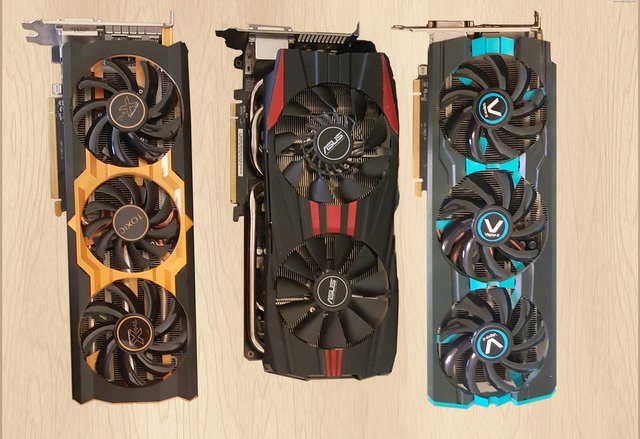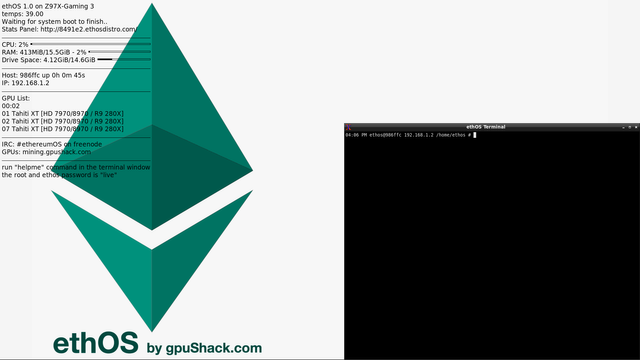How to build an Ethereum mining rig
This guide is going to show you how to build an Ethereum Mining rig yourself which has two main steps - choosing and sourcing your equipment and then putting it together! Depending on times its probably going to take you a week or so to get all the pieces and then another half a day fiddling with configurations etc. Its the same as building your own computer normally but with a few extra considerations that mainly involve which GPU's you pick.
If you don't want to buy mining equipment, You can also try buying a cloud mining contract with Hashflare or Genesis Mining.
Sourcing your Equipment

Your going to have to get hold of a fair few components and the costs stack up quite quickly:
A MotherBoard - A motherboard is the brain of the computer and is what you build everything onto - the base of your mining rig. The main feature you are looking for in a motherboard is the number of GPU slots it has as this will determine how many graphics cards or GPU's it can fit - and in the end your total hashing power. 3 PCI Express slots will mean you can fit 3 x Radeon HD 7950 with a hashrate of 20 MH/s each - or a total hashing power of 60 MH/s. A PCI Express slot is a connection port on the motherboard and looks like the picture below - they are often coloured white but can be beige - you can get other types of slots but most GPU's work on a PCI express.
We used the GA-Z97X-Gaming 3 which you can get here!Graphics Card - Pick your GPUs! Some graphics cards cost a fortune but don't hash much whilst some are more reasonable but use more power. Ultimately its a balance between how powerful you want your rig to be and how much you want to spend - but a word to the wise - make sure you pick an efficient GPU. You can buy second hand GPU's from reputable providers such as GPU Shack - be careful though when you buy them off a street corner as often they have problems that you won't see until you get the card home and plugged in.
We have a list of GPU's here that you can sort through and work out what fits your budget.
Another issue you can have with your graphics cards and your motherboard is that they just won't all fit in together nicely because of the spacing on the motherboard between the PCI Express slots. Fear not - you can use a GPU riser that is basically an extension cable for a PCI Express slot. Some graphics cards are really quite bulky so be careful when you are making your selection. You can get a riser here.
3.Hard Drive - You need a hard drive to store your operating system and your software for mining. A standard SSD drive will do (an SSD hard drive is just a storage device and is called solid state as there aren't moving bits which can break). The size will depend on what you are planning to do when mining. If you are planning to download the entire blockchain and mine as shown in this guide here - then you will need to take into account how big the blockchain will become and need to spend a little more. If you are just going to mine ethereum as part of a pool then you don't need to store the blockchain and can get a smaller SSD drive. We used the SSDNow V300 120GB. Buy it here.
4.RAM - or Random Access Memory - this is a basic component in any computer is basically a scratchpad for jotting down calculations and recalling information quickly in a computer. 4GB should do the job.
You can get some here.
5.A PSU or Power Supply Unit - Power supply units come in many sizes and this can trip some people up when they are looking at calculating what size they need. You need to sum up the power consumption of your GPU and all the other components and make sure your power supply has the capability to supply more! So if you have two GPU's that consumes 220 Watts and other components that need 250 Watts then you can get away with a 750 Watt power supply unit as the total power needed is only 690Watts.
If you are building a "mega rig" which has 6 GPU's you might find it more cost effective to have two separate power supplies because at 750 Watts and $100 each rather than a 1500 W and $300 dollars!We got a Seasonic 1200 Watt which you can buy here.
6.A Case - Again this can be quite a difficult choice to make as it will depend on your GPU's and whether you are using GPU risers. You don't want components sitting on top of each other as there is a fire hazard potentially. You can leave the whole system open air or even build your own case to give it that personalised touch. You can buy off the shelf rigs from a couple of providers - for example SW mining here have their own set of rigs that take up to a week to ship. They do all the hard work for you.
Alternatively you can source some of you components from gpuShack, on our second mining rig we are using the MOBO/CPU/RAM/SSD Bundle for 5 GPUs. Remember to use the promo code CRYPTOCOMPARE gets 5% discount off your purchase.
Putting it together
As mentioned make sure your power supply unit can handle the Graphics cards and that you have risers capable of placing extra GPU's in a safe location. Make sure all the connections are in nicely and everything is held together firmly.
A word on positioning. GPU's can get hot - especially if you overclock them so be sure to get the best bang for your buck - and to be safe to place your rig in a well ventilated area so it doesn't overheat.
Once it switches on you need to make sure all the software is there for you to get it mining!
Software for your Rig
The first thing you need to do is install an operating system on your computer. For the more technically minded there is linux Ubuntu but for the majority Windows is probably best as it automates installing drivers for your computer to talk correctly amongst all the components. The advantage of Ubuntu is it gives you more options and its free!
You can donwload EthOs which is a specifically designed APP for Ethereum Mining - you can read more about this here but its a great way of having a bespoke mining system for your rigs and GPU's to manage them!
Once you have installed the operating system there are two ways you can mine:
- Solo Mining - Solo mining means its you against the rest. If your hash is correct you win the block reward. But with a rig of 60 MH/s and a network hashing power of 1.2 GH you aren't going to get ether very often. The other issue is you have to download the blockchain for yourself. [See our guide here on how to solo mine ethereum](https://www.cryptocompare.com/mining/guides/how-to-mine-ethereum/).
- Pool Mining - This is where you team up with other miners to reduce the volatility of your returns. This means whether you get 5 ethere every 5 days or 1 ether every day. The advantage of this is you get a continuous stream of ether and you don't have to download the entire blockchain. Check out our guide on [how to mine ethereum as part of a pool here](https://www.cryptocompare.com/mining/guides/how-to-connect-to-an-ethereum-mining-pool/).

Nice topic
Very interested in mining Monero and Ether. Thank you for this post. This certainly gives me great ideas.
I'm really surprised more of these mining rig how-to guides aren't getting more support.